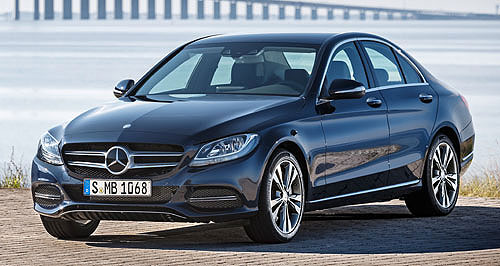Make / Model Search
News - Mercedes-BenzMercedes-Benz debates C-Class hybrid line-upShort circuit: Mercedes' new plug-in C350e has thrown up a quandry for the German company's Australian arm: does it keep the C300 BlueTec Hybrid. New plug-in hybrid Mercedes C350e means current C-Class hybrid might be axed in Oz19 Mar 2015 MERCEDES-BENZ Australia/Pacific (MBAP) is debating whether it should keep its current hybrid diesel-electric C-Class sedan that it launched only four months ago in the event it secures the more sophisticated plug-in hybrid C350e for this market. Although a final decision on the C350e for Australia is still pending, one factor that is already under discussion at the Australian Mercedes headquarters in Melbourne is whether the two hybrid C-Class variants could run in parallel or if the C300 BlueTEC Hybrid should go to make way for it. MBAP has its hand firmly up for the newer C350e that is just about to go into European showrooms this month, three months after its debut at the Detroit motor show. As well, it wants the big S500e plug-in hybrid as an environmental flagship at the top of its range. The two plug-in electric vehicles (PHEVs) are among 10 that Mercedes-Benz is committed to bringing to market by 2017 – an average of one every four months. These models all share a new-generation modular parallel hybrid system that has a much greater electric running range – more than 30km in the case of the C350e – as well as better efficiency and performance. MBAP senior manager of public relations, product and corporate communications David McCarthy told GoAuto that the C350e and S500e were both on the company's wishlist for Australia but that negotiations on price and other factors still had to be completed before a decision could be made. He said that if the C350e got the tick, it possibly could arrive late this year or – more likely – in early 2016. Mr McCarthy said similar negotiations were going on for the S500e – previously called the S500 Plug-in Hybrid – that he said would fill a small niche in the Australia market but fill an important role as a technology leader. “It makes a statement,” he said. Asked if the current hybrid C-Class, the C300 BlueTec Hybrid, would continue if the C350e arrived, he said: “That's an interesting question. The C300 hybrid has been doing quite well since we launched it. “It is going to depend on price and such factors.” Mr McCarthy said the argument to drop the C300 BlueTec Hybrid for the C350e included the need to avoid further complexity in the range. “We are having a robust conversation on all these things,” he said. Mr McCarthy said it was too early to say how many of the 10 Mercedes PHEVs due by 2017 would end up in Australia, but he was keen to see them offered to Australian customers. “I believe this is the future of motoring,” he said. Unlike the C300 BlueTec Hybrid that has a “mild hybrid” powertrain with an electric motor hooked up to a four-cylinder diesel engine, all of the new PHEV models employ a variation of Mercedes’ new modular parallel hybrid system that has a clutch between the electric motor and petrol engine to decouple the engine for all-electric driving and to permit the engine to engage during take-off. The battery can be charged from a household powerpoint and topped up from regenerative braking while driving, while the C300 BlueTec Hybrid depends on regenerative braking to charge the battery. The C350e combines 2.0-litre turbo petrol engine and 60kW electric motor fed by a 6.2 kWh battery, producing a peak output of 205kW and 600Nm for acceleration from zero to 100km/h in 5.9 seconds. It can be driven up to 31km on a full electric charge – much further than the minimal electric driving range of an ordinary hybrid. The C350e is thus more fuel efficient, using just 2.1 litres of petrol per 100 kilometres on official combined fuel economy tests in Europe, against the less sophisticated C300 BlueTEC 3.8L/100km. As well, the C300 BlueTec Hybrid is less powerful, with 150kW of power and 500Nm of torque, and takes a slower 6.4 seconds to achieve 100km/h.  Read more |
Click to shareMercedes-Benz articlesResearch Mercedes-Benz Motor industry news |











Facebook Twitter Instagram